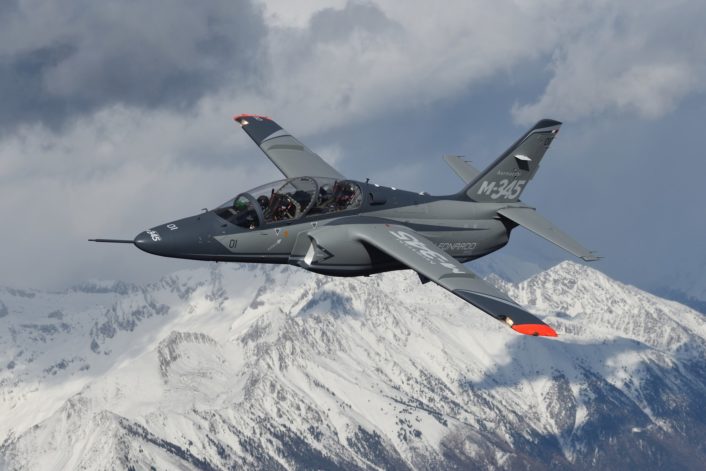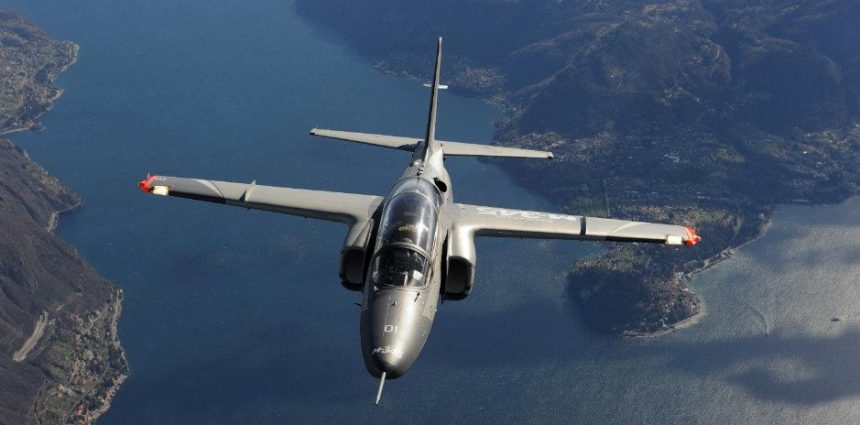The Italian Air Force will replace its aging fleet of MB-339s with the “new” M-345HET.
Following an initial contract for five aircraft, Leonardo has signed yesterday a contract with the Armaments and Airworthiness Department of the Italian Ministry of Defence for the supply of 13 M-345 HET (High Efficiency Trainer) aircraft. The contract, worth 300M Euro includes ground-based training systems and a five year logistics support package.
The HET is a further development of the M-345 jet trainer (formerly M-311 – an upgraded jet based on the Siai S-211 airframe), a basic jet trainer whose first production example successfully performed its maiden flight on Dec. 21, 2018. The M-345 HET is equipped with a turbofan engine in the 1.600 kg (3,500 lb) thrust class and will feature long endurance, high load factors (+7/-3,5 g), HUD (Head Up Display) in the front cockpit with repeater in the rear cockpit, MFDDs (multi-function digital displays) for both pilot stations and HOTAS (Hands On Throttle-And-Stick) controls.
The first of 18 new M-345HET is expected to be delivered in 2020 at the 61° Stormo (Wing), based at Galatina, Lecce, in southeastern Italy.
With three depending squadrons (212°, 213° and 214° Gruppo) and three flight lines (MB-339CD and MB-339A – respectively designated FT-339C and T-339A – and M-346, designated T-346A), the 61° Stormo is a Flight School whose task is to train Italian and foreign student pilots.

The courses currently available at Lecce cover the so-called Phase 2, 3 and 4 of pilot training, held in accordance with the IPTS (Integrated Pilot Training System) 2020, a training model that incorporates the lessons identified in the last decades (including the need for advanced jet trainers, simulators, and a revised screening and selection process), and allows a better cost management by reserving precious jets flight hours to those student pilots whose flight and academic performance ensure considerable chances to reach a fighter jet assignment.
With the IPTS-2020, the training paradigm has turned from Generalized to Specialized: unlike what happened in the past, when all the student pilots (SPs) who had passed the initial flight screening (Phase 1) received the same instruction until graduation (end of Phase 3), with the SUPT (Specialized Undergraduate Pilot Training) all the SPs get the same education only during the initial and basic jet training (Phase 2), currently carried out by 213° Gruppo on the T-339A, then they are assigned to one of four different tracks based on skills: Fighter, Multi-engine, Helicopter or RPA (Remotely Piloted Aircraft). Those who are selected to continue with a Fighter track assignment remain at Lecce with the 213° to undertake the Advanced and Tactical jet training (Phase 3). Upon finishing Phase 3, SPs are awarded the “Military Pilot” license, earn the pilot wings and then move on to LIFT (Lead-In to Fighter Training) course (Phase 4) carried out by 212° Gruppo on the T-339C and the T-346A.
The plan is to field around 45 M-345 (to be designated T-345) to replace a fleet of 137 MB-339A and CD delivered since the early 80s. The new aircraft will also become the new platform of the Italian Air Force’s Frecce Tricolori display team.
Therefore, in the future, Phase 2 and 3 should be carried out with the M-345 and Phase 4 will be carried out by M-346 “Master” Advanced Jet Trainers (18 of those are already in service with the Italian Air Force). Dealing with the latter ones, during Farnborough Air Show 2018, Leonardo’s CEO, Alessandro Profumo, and the Italian Air Force Chief of Staff, Lt. Gen. Enzo Vecciarelli, signed a collaboration agreement to strengthen the training services already offered by the 61° Stormo and to establish an all new “International Flight Training School” (IFTS) to support military pilot training.
“The IFTS will ensure the further growth and internationalization of the Italian Air Force’s training school while at the same time increasing its capabilities and the range of pilot training solutions offered to the customers. The IFTS will leverage the existing training assets and expertise in advanced military pilot training of the Italian Air Force in addition to Leonardo supplying four additional M-346 aircraft, new systems and services starting from 2019,” said the official Leonardo statement back then. “Based on the current plan, the IFTS will be able to deliver courses for Italian Air Force and international Air Force crews, fulfilling the training demands for military pilots worldwide. Starting from 2021, the Italian Air Force’s entire advanced and pre-operational training syllabus will be moved to a new, dedicated facility.”
The IFTS will focus on Phase 4 and will enable to address the growing demand for pilot training from foreign air forces while foreseeing a possible further expansion with another base in Italy (Decimomannu being the most likely one).









